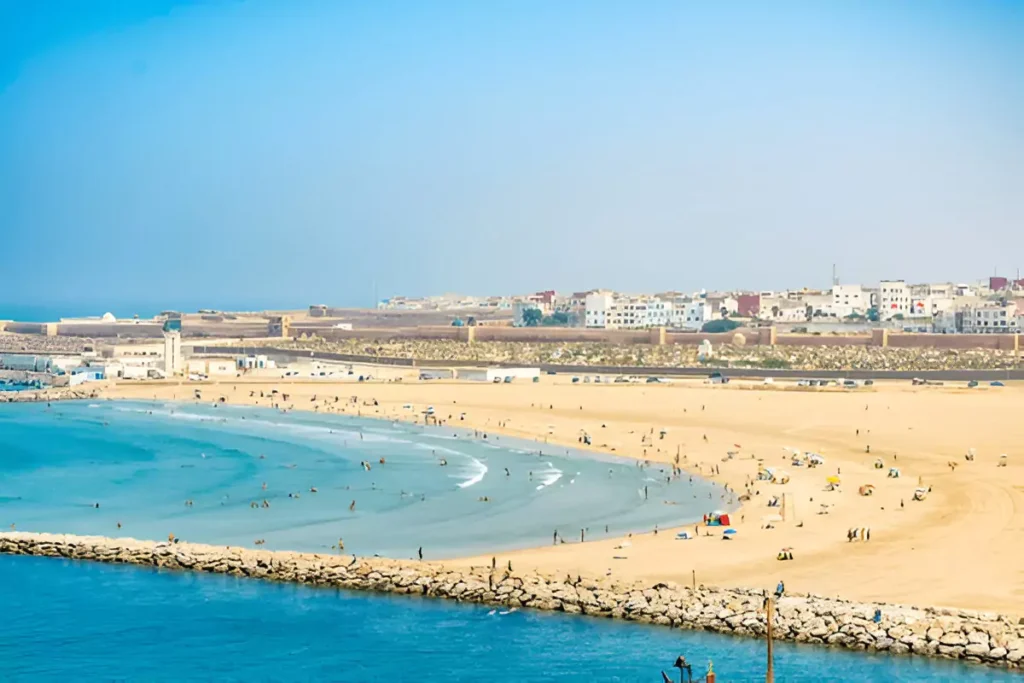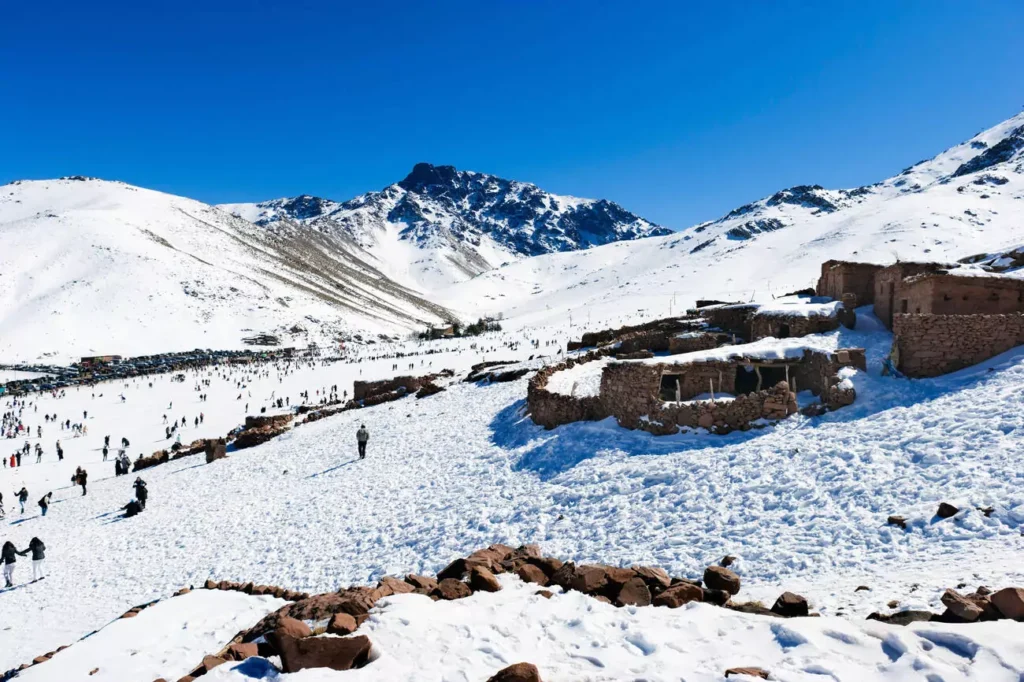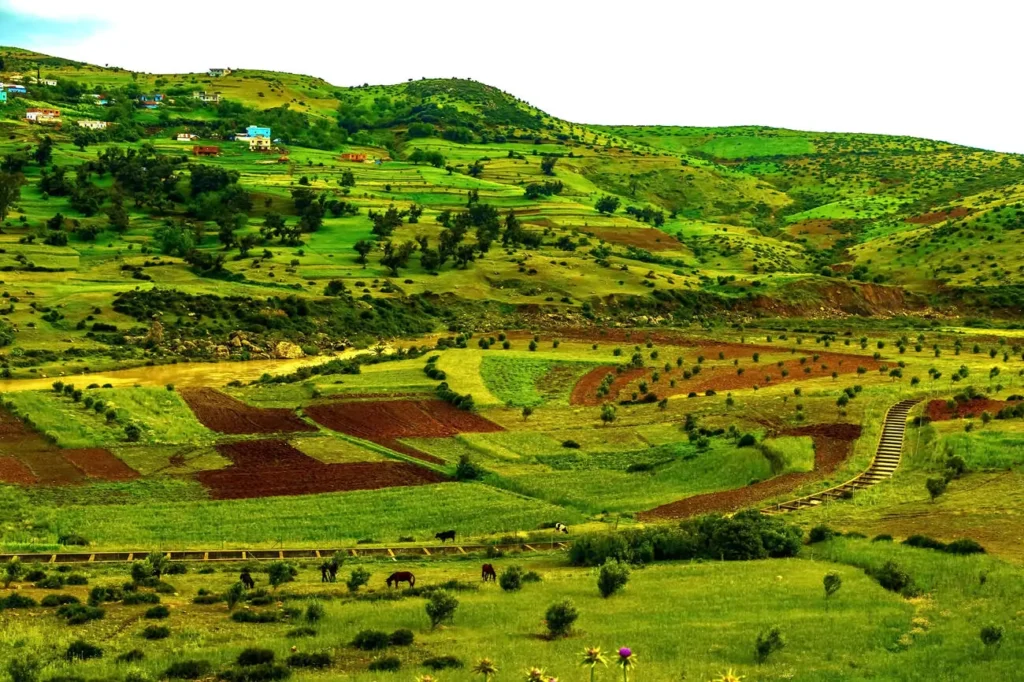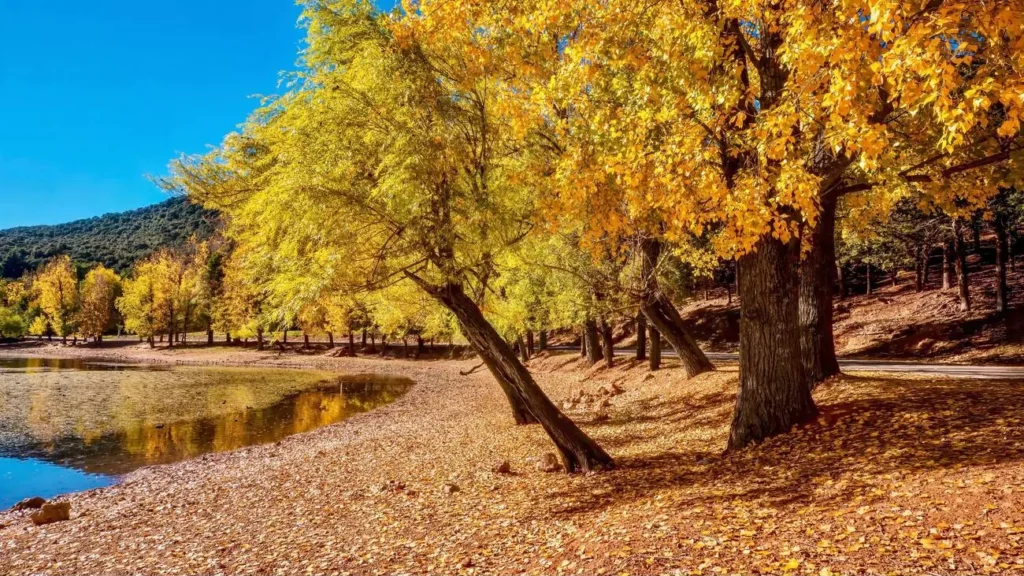Planning a trip to Morocco and wondering when to go? The best time to visit Morocco depends entirely on your travel preferences, planned activities, and tolerance for different weather conditions. While this North African gem offers year-round appeal, understanding when to visit Morocco can make the difference between a good trip and an extraordinary one.
Key Takeaway: For generally pleasant weather and balanced tourist numbers, Spring (April-May) and Autumn (September-October) are widely considered the best times to visit Morocco. However, the optimal period truly depends on your specific interests, destinations within Morocco, and tolerance for varying conditions.
This comprehensive guide provides an in-depth analysis of Morocco’s diverse climate patterns, regional weather variations, and optimal timing for different activities. Whether you’re planning to explore bustling medinas, trek the Atlas Mountains, or venture into the Sahara Desert, this resource will help you determine when to go Morocco based on your unique travel goals.

Detailed Seasonal Breakdown
Spring (March – May)
General Climate & Atmosphere
Spring represents one of the most favorable periods for Moroccan travel, offering mild temperatures and blooming landscapes across the country.
| Region | Temperature Range | Conditions |
|---|---|---|
| Marrakech | 20-26°C (68-79°F) | Warm days, cool evenings |
| Fes | 18-24°C (64-75°F) | Pleasant and mild |
| Coastal Areas | 19-23°C (66-73°F) | Gentle ocean breezes |
| Atlas Mountains | 15-20°C (59-68°F) | Perfect for trekking |
| Sahara Desert | 24-30°C (75-86°F) | Comfortable desert conditions |
Why Visit Morocco in Spring
- Ideal weather for outdoor exploration and photography
- Wildflowers blooming throughout the countryside
- Comfortable temperatures for city walking tours
- Lower humidity levels
- Excellent visibility for mountain and desert landscapes
Potential Considerations:
- Occasional spring showers, particularly in northern regions
- Popular travel season means higher accommodation demand
- Desert nights can still be quite cool
Recommended Activities & Experiences: Spring weather makes it perfect for exploring Imperial Cities like Marrakech and Fes, hiking in the lower Atlas Mountains, and enjoying the emerging flora across Morocco’s diverse landscapes. This season offers excellent conditions for photography enthusiasts seeking vibrant colors and clear skies.
Regional Highlights This Season: The Middle Atlas region showcases stunning wildflower displays, while coastal cities like Essaouira offer perfect weather for exploring medinas and beaches. The Anti-Atlas mountains provide spectacular hiking conditions with comfortable temperatures.
Notable Festivals & Cultural Events:
- Rose Festival in Kelaat M’Gouna (typically May)
- Various local moussems (religious festivals) throughout the season
Summer (June – August)
General Climate & Atmosphere
Summer in Morocco varies dramatically by region, from scorching inland temperatures to pleasant coastal conditions.
| Region | Temperature Range | Conditions |
|---|---|---|
| Marrakech | 27-38°C (80-100°F) | Very hot, dry heat |
| Fes | 25-35°C (77-95°F) | Hot with occasional cooling |
| Coastal Areas | 22-28°C (72-82°F) | Cooled by ocean breezes |
| Atlas Mountains | 20-30°C (68-86°F) | Warm days, cool nights |
| Sahara Desert | 35-45°C (95-113°F) | Extremely hot |
Why Visit Morocco in Summer:
- Perfect coastal weather for beach activities and water sports
- Long daylight hours maximizing sightseeing time
- High-altitude mountain regions offer escape from heat
Potential Considerations:
- Extreme heat in desert and inland regions
- Intense sun requires careful protection
Recommended Activities & Experiences: For those who visit Morocco in summer, focus on coastal regions like Casablanca, Rabat, and Essaouira for comfortable sightseeing. High-altitude Atlas Mountain treks become more accessible during this period.
Autumn (September – November)
General Climate & Atmosphere
Autumn offers another prime window for visiting Morocco, with temperatures cooling from summer extremes while maintaining pleasant warmth.
| Region | Temperature Range | Conditions |
|---|---|---|
| Marrakech | 22-30°C (72-86°F) | Warm, comfortable |
| Fes | 20-28°C (68-82°F) | Pleasant temperatures |
| Coastal Areas | 20-26°C (68-79°F) | Mild and breezy |
| Atlas Mountains | 15-25°C (59-77°F) | Excellent trekking conditions |
| Sahara Desert | 25-35°C (77-95°F) | Ideal desert weather |
Why Visit Morocco in Autumn:
- Excellent all-around weather conditions
- Perfect timing for desert exploration
- Comfortable conditions for both city exploration and outdoor activities
Recommended Activities & Experiences: Autumn provides optimal conditions for comprehensive Morocco exploration, from Atlas Mountain trekking to Sahara Desert adventures.

Winter (December – February)
General Climate & Atmosphere
Winter brings Morocco’s mildest temperatures to lowland areas while mountain regions may experience snow and cold conditions.
| Region | Temperature Range | Conditions |
|---|---|---|
| Marrakech | 12-22°C (54-72°F) | Cool days, cold nights |
| Fes | 8-18°C (46-64°F) | Cool with occasional rain |
| Coastal Areas | 14-20°C (57-68°F) | Mild Mediterranean climate |
| Atlas Mountains | 0-15°C (32-59°F) | Cold, possible snow |
| Sahara Desert | 15-25°C (59-77°F) | Pleasant days, very cold nights |
Why Visit Morocco in Winter:
- Comfortable temperatures for city exploration
- Fewer tourists mean better prices and smaller crowds
- Perfect weather for coastal cities
Recommended Activities & Experiences: Winter excels for cultural immersion in cities, coastal exploration, and desert adventures. Lower elevation hikes remain enjoyable while high mountain trekking becomes challenging.
Best Time by Interest/Activity
For Sahara Desert Exploration
Optimal Months: October through April
The desert’s extreme temperature variations make timing crucial for comfortable exploration. During peak summer (June-August), daytime temperatures regularly exceed 45°C (113°F), making outdoor activities dangerous.
Best Conditions:
- October-November: Warm days (25-30°C), cool nights
- December-February: Pleasant days (15-25°C), very cold nights
- March-April: Warming days (20-30°C), comfortable nights
What to Expect: Desert nights can drop to near freezing in winter months, requiring warm sleeping gear for overnight camping experiences.
For Hiking & Mountain Trekking
Optimal Months: April through June, September through November
Atlas Mountains Conditions:
- Spring (April-June): Perfect temperatures, accessible trails, blooming wildflowers
- Summer (July-August): High altitude treks become more comfortable while lower elevations remain hot
- Autumn (September-November): Excellent conditions with stable weather and clear views
- Winter (December-March): Limited high-altitude access due to snow, but lower elevation hikes remain possible
Trail Accessibility: Many high-altitude passes close during winter months due to snow accumulation.
For Coastal Relaxation & Water Sports
Optimal Months: May through October
Morocco’s Atlantic coast offers year-round appeal, but summer months provide the warmest ocean temperatures and most reliable sunny weather.
Surfing Conditions:
- Best Waves: October through April
- Warmest Water: July through September
- Optimal Balance: May-June and September-October offer good waves with comfortable temperatures
For Immersive City & Cultural Tourism
Optimal Months: March through May, October through November
These periods offer the perfect balance of comfortable walking weather and manageable tourist crowds, making them the best time to visit Morocco for cultural experiences.
City-Specific Timing:
- Marrakech: Avoid July-August due to extreme heat
- Fes: Spring and autumn provide perfect medina exploration weather
- Casablanca: Year-round destination with mild coastal climate
For Photography Enthusiasts
Optimal Months: October through April
Lighting Conditions:
- Golden Hour Quality: Winter months offer longer golden hour periods
- Clear Skies: Autumn and winter provide the clearest atmospheric conditions
- Landscape Colors: Spring brings vibrant wildflowers, while autumn offers harvest colors
For Travelers Seeking Fewer Crowds
Optimal Months: November through February (excluding December holidays)
Summer heat naturally reduces tourist numbers in inland areas, but weather conditions make sightseeing uncomfortable. Winter months offer the best combination of manageable crowds and pleasant weather.
For Experiencing Major Cultural Events
Ramadan Considerations (dates rotate annually based on lunar calendar):
Ramadan offers unique cultural insights but requires understanding of changed daily rhythms. Many restaurants close during daylight hours, while evenings become particularly vibrant with iftar celebrations.
What to Expect:
- Altered business hours for many establishments
- Reduced daytime dining options
- Enhanced evening cultural atmosphere
- Respectful behavior expectations during daylight hours

Regional Climate Variations
Morocco’s diverse geography creates distinct climate zones, each with optimal visiting periods.
Coastal Morocco (Atlantic & Mediterranean)
Characteristics: Mild, Mediterranean-influenced climate with cooling ocean breezes
Best Visiting Periods: Year-round destination with peak comfort May through October
Regional Highlights:
- Atlantic Coast: Consistent mild temperatures, excellent for year-round travel
- Mediterranean Coast: Slightly warmer than Atlantic regions, perfect summer destination
The Atlas Mountains
Altitudinal Impact: Temperature drops approximately 6°C per 1000m elevation gain
Seasonal Accessibility:
- High Atlas: Best accessed April through October
- Middle Atlas: Comfortable March through November
- Anti-Atlas: Year-round accessibility with peak conditions in spring and autumn
Trekking Seasons:
- Prime Season: April-June and September-November
- High Altitude: July-August for peaks above 3000m
- Winter Limitations: Many passes inaccessible December-March
The Sahara Desert Regions
Temperature Extremes: Daily variations of 20-30°C common throughout the year
Optimal Visiting Windows:
- Best Overall: October through April
- Most Comfortable: November through March
- Extreme Caution: June through August (dangerous heat levels)
Desert Microclimates:
- Erg Chebbi (Merzouga): Slightly more moderate than western desert regions
- Erg Chigaga: More remote with potentially more extreme conditions
Inland Plains & Imperial Cities
Seasonal Weather Patterns:
- Continental Climate: Hot, dry summers and mild winters
- Temperature Extremes: Greatest variation between seasons
- Optimal Periods: Spring and autumn for comfortable exploration
City-Specific Considerations:
- Marrakech: Intense summer heat makes April-May and October-November ideal
- Fes: Similar to Marrakech but slightly cooler due to higher elevation
- Meknes: Most moderate of imperial cities due to elevation and location
Key Factors Influencing Your Decision
Tourist Density Throughout the Year
Peak Season (March-May, September-November):
- Higher accommodation prices
- Crowded attractions and restaurants
- Advanced booking essential
- Enhanced cultural activities and tours
Shoulder Season (February, June, December):
- Moderate prices and crowds
- Good availability with some advance planning
- Weather may be less predictable
Off-Peak Season (July-August inland, January):
- Lower prices and fewer crowds
- Weather extremes require careful planning
- Some services may have reduced hours
Daylight Hours and Sightseeing Impact
Summer Solstice (June): Up to 14 hours of daylight Winter Solstice (December): Approximately 10 hours of daylight
Practical Impact:
- Summer’s long days maximize sightseeing potential
- Winter’s shorter days require efficient itinerary planning
- Autumn and spring offer balanced daylight with comfortable temperatures
Ramadan & Major Public Holidays
Ramadan Impact on Travel (rotating dates based on lunar calendar):
Cultural Significance: Holy month of fasting from dawn to sunset for Muslim population
Traveler Experience:
- Daytime restaurant closures in many areas
- Reduced business hours for some services
- Enhanced evening cultural atmosphere
- Opportunity for cultural understanding and respect
Other Key Public Holidays:
- Eid al-Fitr: End of Ramadan celebration
- Eid al-Adha: Major Islamic holiday
- Independence Day (November 18): National celebration
- New Year: Both Islamic and Gregorian calendars observed

Frequently Asked Questions
Is April a good month to visit Morocco?
Yes, April is excellent for Morocco with temperatures around 20-26°C, minimal rain, and perfect conditions for all activities including desert exploration and city tours.
What is the hottest month in Marrakech?
July and August are hottest, reaching 38-40°C (100-104°F). Most tourists avoid these months due to uncomfortable heat.
Can I visit the Sahara Desert in July?
Not recommended. July temperatures exceed 45°C (113°F), making it dangerous. October-April is the best time to visit Morocco for comfortable desert conditions.
How does Ramadan affect tourists in Morocco?
Many restaurants close during daylight hours, but evenings become very festive. Show respect by not eating/drinking publicly during the day.
Which season offers the best value for visiting Morocco?
Winter months (except December holidays) offer lower prices and fewer crowds, though with shorter daylight hours and cooler weather.
Conclusion
Morocco welcomes travelers year-round, but choosing the right time transforms a good trip into an unforgettable adventure. Spring and autumn offer the perfect balance of comfortable weather and manageable crowds.
Your ideal Morocco awaits when your dreams align with the seasons. Whether drawn to April’s blooming landscapes or October’s harvest warmth, this incredible country rewards every traveler who ventures forth with curiosity and respect.
